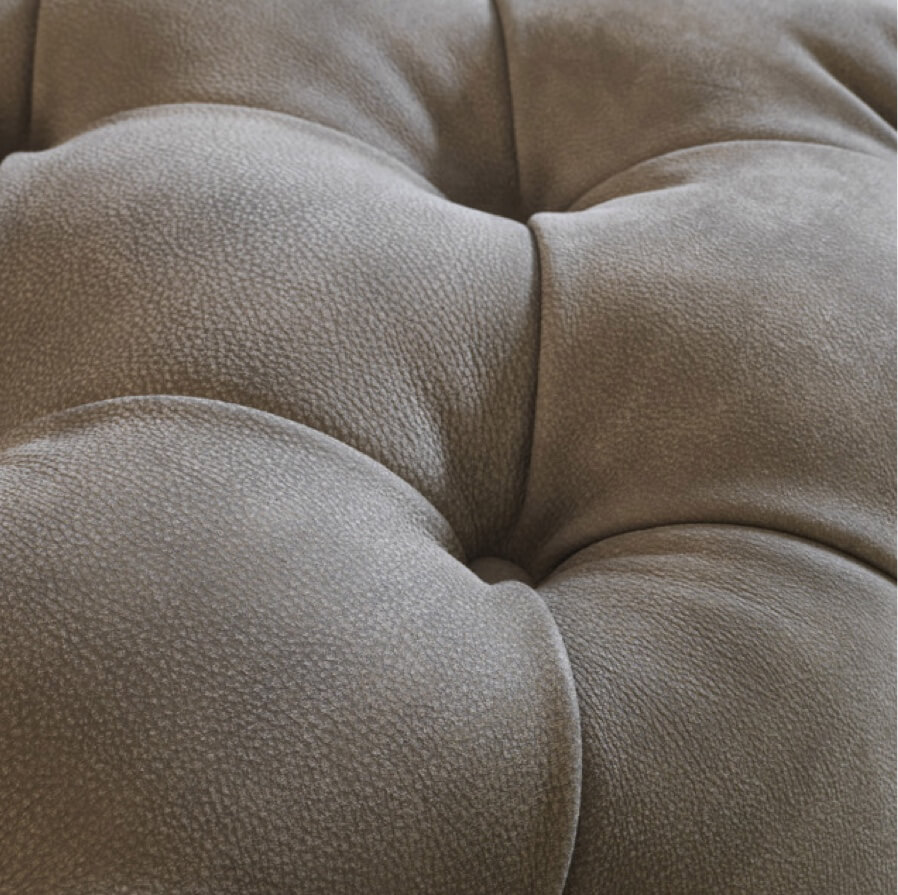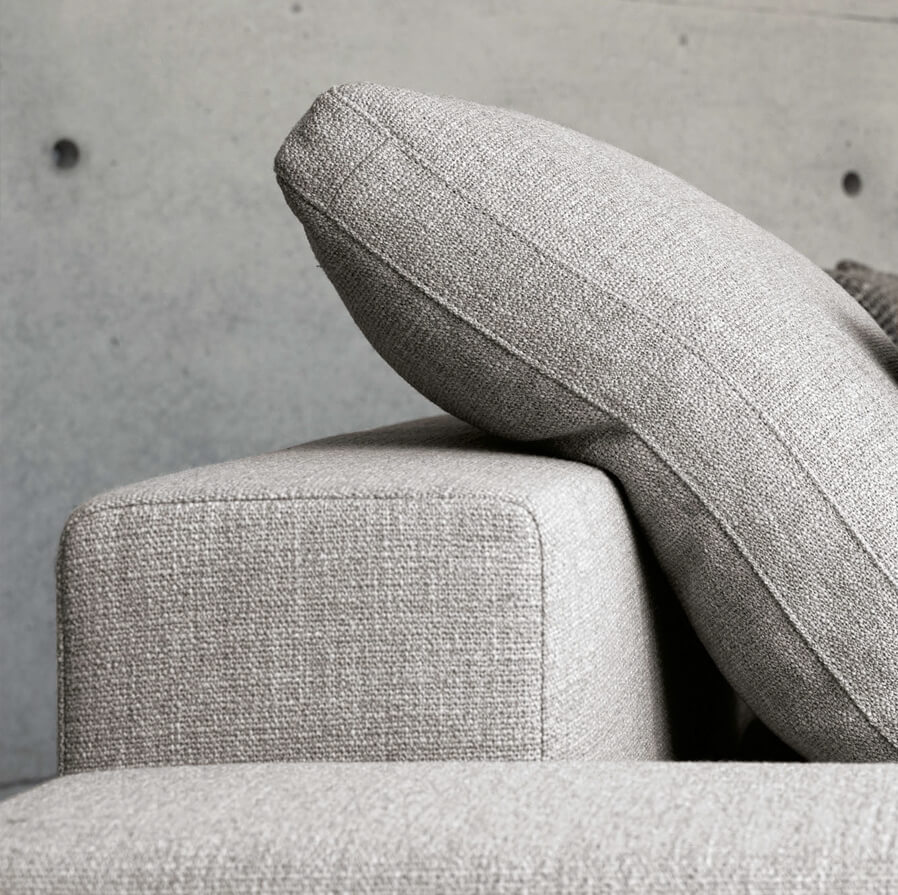Materials

Our fabrics
The characteristics of textile products essentially depend on the type, quality and quantity of the fibre and on how it is processed. Fibres can be natural (wool, silk, cotton, linen, hemp, etc.), artificial (viscose, acetate, etc.) or synthetic (polyester, acrylic, etc.) Our fabrics comply with the reliability requirements set by the UNI standards for upholstered furniture covers and with our company’s quality standards.The most important aspects that determine the quality of a fabric are its resistance to abrasion, to fading when exposed to light and to pilling.

Our leathers
The leather selected by Desiree is mainly cowhide from the best pastures which ensures quality aesthetics, is soft to touch and doesn’t change over time. Leather is a natural, breathable product that does not cause allergies, adapts to the temperature of the human body and is easy to dust. The most prized side of leather, its coated surface, is called the grain side. It is called “full grain” leather when it is unimpaired and has a natural grain, has not been sanded and displays the marks collected by the animal when it was alive (scars, differences in grain, lines, etc) which testify to the natural quality of the leather. Corrected grain leather has been sanded with emery paper. Before being used, full grain leather must pass the tests set by the UNI standards.

Paddings
The main features of padding for an armchair, sofa or bed are: softness, which concerns the ability to adequately support and distribute body weight; breathability, for heat and humidity dispersion from the human body and for a pleasurable sensation of wellbeing; and reliability, which indicates the performance of elastic materials over the years.
The ecological aspect must be added to all this: protecting the environment is a fundamental requirement. The materials used are: polyurethane, down and wadding. Polyurethane is created from the chemical reaction of polymerization combined with the physical reaction of expansion.
Maintenance
Avoid products containing solvents or cleansers and always use a soft and non-abrasive cloth

Maintenance of leather
In most models, the leather upholstery is completely removable. The maintenance of a skin depends on the type of flower. The "full grain" gives maximum comfort and less resistance to stains, the "corrected grain" gives a less comfort but more resistant to stains. For normal cleaning of the skin using a cotton cloth mild non-abrasive soft cloth dampened with water and skim milk in equal parts. The liquid or other substance accidentally fell, should be removed immediately by blotting gently with a damp sponge or even eliminating, never wipe vigorously. In the case of stubborn stains use products for cleansing the skin, do not use solvents or alcohol.

Maintenance of fabric
Fabric covers are entirely removable. This enables maintenance and replacement of the covers without the assistance of a technician. For routine cleaning, it is advisable to regularly brush the covers using a soft brush. Routine maintenance operations include: airing, washing, drying and ironing. Four factors need to be considered when washing in water or dry cleaning: the temperature, the time, the detergent and the mechanical action. Before washing the covers, it is advisable to cover any Velcro with a Velcro covering tape to protect the fabric from abrasion and prevent any damage to the surface. Remember not to fill the washing machine drum completely so that the fabric moves freely, and for large covers we recommend using a professional cleaning service. When washing in water, the addition of fabric softener helps to keep fibres soft and slippery, thus preventing the fabric from rubbing during the washing phases. The maintenance symbols on the label stitched to the covers indicate the recommendations to prevent damaging the fabric. When the fabric is washed for the first time in water, as for a pre-wash, the covers become softer and more elastic. After washing the covers, we recommended not drying them completely so that they remain softer, making it easier to put them back on. After washing, fabrics in natural or artificial fibre undergo slight shrinkage and a slight loss of colour. Only synthetic fibre does not shrink. During the washing stage, 'raw' fabrics in natural colour fibres may release impurities that can be eliminated with further washing. Fabrics with a more complex and heavier weave are more affected by dust. In this case, maintenance is required more frequently to prevent dirt from building up. Viscose and cotton velour are sensitive fabrics and require careful maintenance. The velvety effect and pressure marks are difficult to avoid; a typical property of velours, it is neither a defect, nor a sign of low quality. To prevent flattening of the pile, resulting in an uneven colour effect, we recommend reviving the covers regularly. For more pronounced crushing marks, steam can be used from a distance and at a moderate temperature. Remove stains as soon as possible, soak up liquids with an absorbent cloth. Before removing stains, we recommend testing the products on an inconspicuous area first, to check that the cover is not damaged. The guidelines are purely recommendations and cannot guarantee complete stain removal. We recommend contacting a professional dry cleaner giving details about any treatment undergone. IN+OUT fabrics are washable in water, and regular maintenance will preserve their technical characteristics over time.

Maintenance of pillows
From time to time, we should where possible reverse the position of the seat cushions and back, in order to obtain a uniform softening. Polyurethane cushions give maximum comfort after a few months of use, against rotation of the various components of the padding. cushions in feather or feather mix must be periodically "" spiumacciati "" and exposed to the air, in order to cause the shaking of the material and promote the reabsorption the maximum amount of air. This operation returns to its original shape and cushion minimizes tolerable leakage of foam, do not use a vacuum cleaner.

Other materials
Elements in wood or lacquer must be cleaned with a soft cloth moistened with diluted alcohol in plenty of water (about 90%) and dried immediately. Wood products must be cleaned in the direction of the grain. When cleaning lacquered elements for the first time, the cloth may remove any lacquer dust from the surface. It is advisable to use specific detergents for other materials. Avoid using products that contain solvents or abrasive detergents, and always use a soft non-abrasive cloth.